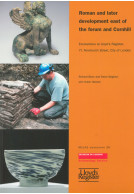Google Books previews are unavailable because you have chosen to turn off third party cookies for enhanced content. Visit our cookies page to review your cookie settings.
Archaeological landscapes of east London (Hardback)
Imprint: MOLA (Museum of London Archaeology)
Series: MoLAS Monograph
Pages: 144
ISBN: 9781907586002
Published: 15th April 2011
Script Academic & Professional
Series: MoLAS Monograph
Pages: 144
ISBN: 9781907586002
Published: 15th April 2011
Script Academic & Professional
You'll be £14.00 closer to your next £10.00 credit when you purchase Archaeological landscapes of east London. What's this?
+£4.99 UK Delivery or free UK delivery if order is over £40
(click here for international delivery rates)
Order within the next 1 hour, 13 minutes to get your order processed the next working day!
Need a currency converter? Check XE.com for live rates
(click here for international delivery rates)
Order within the next 1 hour, 13 minutes to get your order processed the next working day!
Need a currency converter? Check XE.com for live rates
Six multi-period archaeological sites investigated in advance of gravel extraction in the London Borough of Havering between 1963 and 1997 form the basis of a landscape history of the Rainham and Upminster area. Residual Mesolithic finds from the study area include an adze. The first significant activity locally was an Early Neolithic ring ditch, which remained in use for about a millennium. During the Bronze Age the area was transformed by extensive woodland clearance and the creation of rectilinear fields and scattered farmsteads. The Iron Age saw more intensive landscape utilisation and settlement. About the time of the Roman invasion two farmsteads were fortified. A waterhole from one of these farmsteads revealed a large pottery assemblage dating to c. AD 60-70, showing a low level of Romanisation and few imported wares. A number of farmsteads were continuously occupied throughout the Roman period until after c. AD 370. The presence of Early Saxon activity at some sites suggests either continuity of occupation or only a short period of abandonment. These scattered Saxon farmsteads were probably abandoned during the Late Saxon period, when the rural settlement pattern generally changed to nucleated villages. Significant medieval remains include a farmstead and a manorial enclosure.
Other titles in the series...
Other titles in MOLA (Museum of London Archaeology)...




















